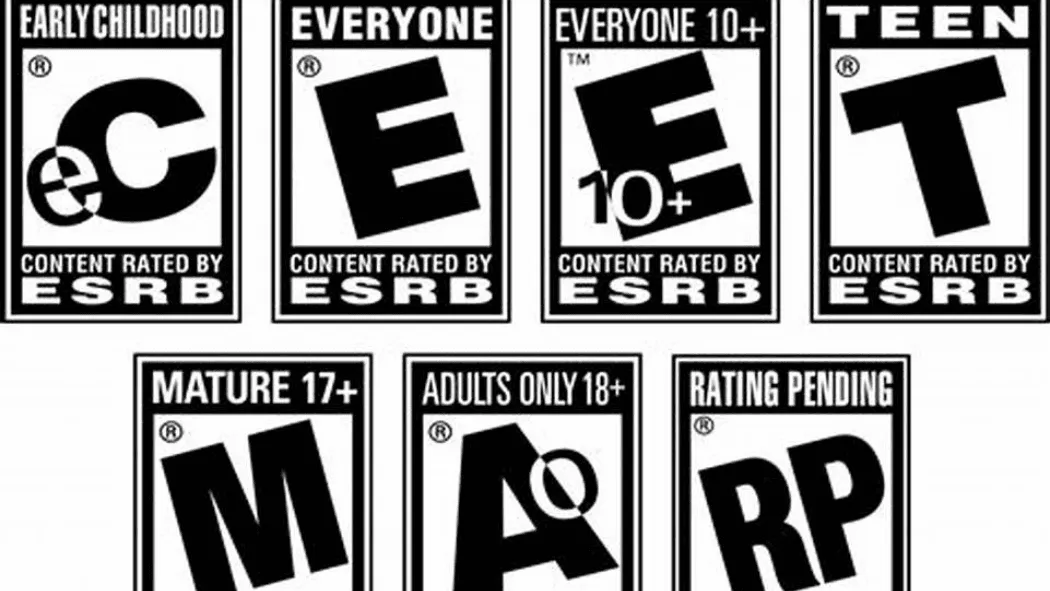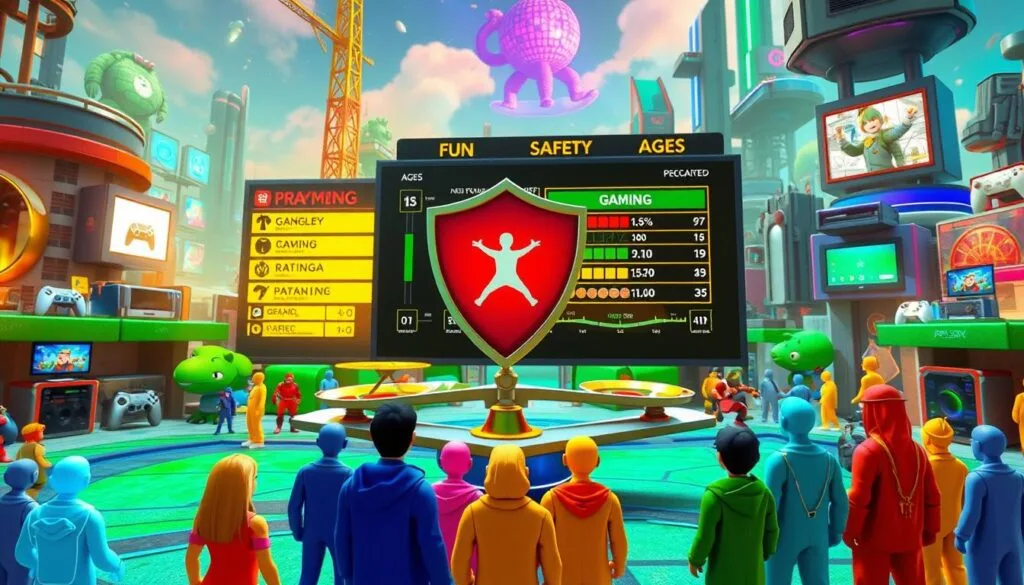Video games are a big part of fun for all ages. But how do you know if a game is right for your age? That’s where games rating systems come in. They help people choose games that fit their age and values.
These systems use game rating criteria to suggest ages and warn about content. This way, everyone can find games that are just right for them. Knowing about games rating helps parents and gamers feel sure about their choices.
Game rating reviews are key in checking games for things like violence and bad words. Details like content descriptors and rating summaries help us see more than just the age rating. Whether it’s the ESRB in North America or PEGI in Europe, knowing these video game ratings guide is key for making good choices.
Key Takeaways
- Games rating systems help determine the suitability of video games for different age groups.
- Understanding game rating criteria is crucial for making informed choices.
- Content descriptors and interactive elements provide context to age ratings.
- ESRB and PEGI are primary games rating systems in North America and Europe, respectively.
- Rating summaries are a valuable resource for parents and guardians.
- Parental controls and ratings awareness can protect children from unsuitable content.
The Importance of Game Rating Systems for Informed Choices
In today’s world, digital media can greatly affect how we think and behave, especially for kids. It’s key to understand how well systems like the game rating system work. These systems help us make smart choices and make sure we’re watching things that are right for our age.
Learning to rate games well means knowing about the different ratings out there. For example, many parents use the ESRB’s ratings to help pick games. They look at online safety tips and reviews on websites and in newspapers, as suggested by the ESRB.
It’s not just about age; the game scoring system also looks at game ratings and reviews. It warns us about things like violence, bad language, and other adult themes. The game rating system is more than just a label; it’s a detailed guide.
| Rating Category | Percentage | Description |
|---|---|---|
| EC (Early Childhood) | 4% | Suitable for ages three and older, with no inappropriate material. |
| E (Everyone) | 47% | Suitable for ages six and older, with minimal violence and mild language. |
| T (Teen) | 23% | Suitable for ages 13 and older, contains violence, mild or strong language, suggestive themes. |
| M (Mature) | 19% | Suitable for ages 17 and older, features intense violence, mature sexual themes, and strong language. |
| AO (Adults Only) | 2% | Appropriate only for adults, with graphic depictions of sex and violence. |
| RP (Rating Pending) | 5% | Awaiting final rating by the ESRB. |
This detailed system helps game ratings and reviews tell us what we’ll see in games. It supports a strong game rating system. The goal is to help users, especially parents and teachers, make smart choices about games. This way, everyone can enjoy games safely and happily.
Unpacking the ESRB Rating System
The Entertainment Software Rating Board (ESRB) rating system helps parents choose the right video games for their kids. It’s important to know how games like Unpacking get their ratings. This way, we can see if the game is right for different ages.
Rating Categories and Age Appropriateness
The ESRB rating system has different levels to show how suitable a game is for each age. It goes from ‘E’ for Everyone to ‘AO’ for Adults Only. This helps sort top rated games into the right categories.
Understanding Content Descriptors
ESRB content descriptors give detailed info on why a game got its rating. They cover things like mild language, suggestive themes, or fantasy violence. These details help users know what to expect, making the ESRB a reliable game review and rating platform.
Interpreting Interactive Elements
The ESRB also looks at interactive elements in games that might change how you play. This includes online interactions and in-game purchases. These are key for understanding online game ratings. They help us see how games might affect children and other players.
| Game Feature | Impact on Rating |
|---|---|
| Online Interactivity | Does not impact age rating but noted for user awareness |
| In-Game Purchases | Flagged under interactive elements |
| User Interaction | Noted, potential for exposure to unfiltered content |
Let’s look at Unpacking, a game that lets you explore a character’s life through their belongings. It’s known for its calm gameplay and simple challenges. The game review shows it’s safe for everyone, fitting the game rating criteria for a family-friendly game.
Decoding PEGI: Europe’s Games Rating Standard
The digital gaming world is growing fast. This makes it crucial to have good gaming reviews and a solid game ranking system. The PEGI rating system in Europe is key. It helps guide both buyers and sellers on what games are right for different ages since 2003.
PEGI’s Distinct Age-Based Ratings
The PEGI rating system stands out because it has specific age groups. It covers kids aged 3, 7, and 12, plus games for everyone. This makes it easy for parents to pick games that are right for their kids. It ensures a safe place for kids to play games.
Games rated by PEGI range from fun family games to more serious ones. This gives gamers a wide range of choices.
The Role of PEGI Descriptors
PEGI descriptors are also very important. They explain why a game got a certain rating. They talk about violence, fear, and language. This helps people know if a game is right for their age group.
Knowing about Europe’s game rating system through PEGI is good. It helps keep gaming safe and makes online reviews better. It gives gamers and parents the info they need to choose wisely.
Navigating the Games Rating Landscape
The world of gaming ratings includes video game rating systems and game review scores. It shapes how people play and make games. This system makes sure games are right for different players.
Looking at gaming ratings shows us how they affect the world. Gamers face different rules in places like North America and Europe. These rules help guide what games are good for kids and help parents choose.
Making games better means using rating info. It helps games fit the right players and helps marketing reach the right people. This shapes how games are made, from money to ideas.
| Gaming Segment | 2023 Projected Revenue | 2026 Forecast Revenue |
|---|---|---|
| Global Games Market | $187.7 billion | $212.4 billion |
| Console Games | $56.1 billion | 30% market share |
| Mobile Games | Rise by 0.8% | Constitute 30% of subscriptions |
| PC Games | $39.1 billion | Moderate growth 0.5% |
The number of gamers is growing fast, reaching 3.79 billion by 2026. This shows how key game scoring systems are. They keep up with society and new tech.
In a fast-changing world of games, knowing about game review scores is crucial. It helps players choose and creators make better games.
Games Rating Criteria: How Titles are Evaluated
Knowing how games are rated is key for both players and game makers. Ratings tell us if a game is right for different ages. This part explains the detailed system used to rate games, focusing on what gets checked and how it affects the rating.
The Assessment Process of Ratings
Games go through a careful rating process. Publishers send their games to rating boards for review. These boards look at both the game’s quality and content, using a strict system to check every part of the game.
Content Factors Considered in Game Ratings
Games are checked for many things before they get a rating. These include violence, language, sexual content, and alcohol or drug use. The goal is to keep the right content away from the wrong age groups, helping players make smart choices.
The table below shows how different countries rate games. It shows how cultural and legal rules affect game ratings around the world:
| Country | Rating System | Categories | Legally Enforced |
|---|---|---|---|
| USA | ESRB | E, E10+, T, M, AO, RP | AO rating legally restricted |
| Germany | USK | 0 to 18 | Certain games banned |
| Australia | Classification Board | G, PG, M, MA 15+, R 18+ | R 18+ introduced in 2013 |
| Japan | CERO | A, B, C, D, Z | Z rating legally restricted |
| Brazil | DEJUS | L, 10, 12, 14, 16, 18 | – |
| Mexico | National | A, B, B15, C, D | Adopted May 2021 |
| Russia | National | 0+ to 18+ | – |
Not knowing how games are rated can lead to the wrong people seeing the wrong content. A good rating system helps players make better choices. It also helps keep the gaming world safe and in line with laws and cultural values.
A Closer Look at Rating Summaries for Parents
In today’s digital world, knowing about game rating summaries is key for parents. These summaries help parents understand the content their kids might see. They are a vital tool for parental guidance in gaming.
Why Rating Summaries Offer Deeper Insight
Game rating summaries do more than just give a number or category. They explain why a game got its rating and what it contains. This includes violence, language, sexual content, and themes. This info is crucial for parents who want to keep an eye on their kids’ gaming.
Using Rating Summaries for Parental Guidance
Just looking at ratings from the ESRB or PEGI isn’t enough. Game content can be different even with the same rating. By using game rating summaries, parents can make choices that fit their values. Top game rating websites provide detailed guides and reviews, making them best game rating websites for parents.
Also, knowing these summaries helps parents use tools like the V-chip to block bad content. Whether picking games or setting up controls, this info helps parents guide their kids’ gaming.
Exploring game review ratings and guides through sites like Common Sense Media is helpful. It helps parents understand how different content might affect their child. With so much media around, knowing about game review ratings and using the a href=”https://topmobilegamer.com/best-website-for-game-reviews/”>top game rating website is key for guiding parents.
International Ratings: Comparing Across Borders
Exploring top game ratings and international ratings shows us how different places classify games. In North America, Europe, and Asia, cultural views and laws shape their rating systems. The ESRB in North America, PEGI in Europe, CERO in Japan, and the Australian Classification Board are key.
Each rating system has its own special features. These match the culture and laws of each area. For example, what’s okay in one place might not be in another. A good game rating website helps by showing these differences. It helps both buyers and makers make smart choices.
| Region | Rating System | Features |
|---|---|---|
| North America | ESRB | Covers various age groups, offers detailed content descriptions |
| Europe | PEGI | Age-based ratings, focuses on the impact of game content |
| Japan | CERO | Age-specific ratings, also considers social norms |
| Australia | Australian Classification Board | Ratings include guidance on violence and drug use |
The top game ratings show how games do well worldwide. They meet different people’s needs. This mix of local rules and global appeal shapes game making.
Knowing these ratings helps in many ways. It’s good for following rules, marketing, or making games. The best games ranking shows more than just what people like. It shows how games connect with the world and follow laws.
Looking at game rating website data gives us a deeper understanding. It tells us why some games do well globally. This knowledge is key in a tough market.
‘Games Rating’ and the Impact on Developer Decisions
Game ratings are key in game development, affecting both creative choices and market positioning. They help developers tailor their games to fit a certain audience and follow rules. This shows how ratings influence game design and marketing strategies.
Game Design and Content Adjustments
To get a high rating, developers might tweak their game. They might change language, reduce violence, or alter sensitive content. These changes help attract the right audience and meet age and cultural standards.
For example, aiming for a wider audience might mean targeting a PEGI 12 rating. This requires big changes in the game’s story and gameplay. These choices are vital in shaping the game’s appeal and how it’s seen by different players.
Marketing Strategies Aligned with Game Ratings
Marketing strategies change a lot based on game ratings. Ads and trailers must follow rating guidelines to avoid fines and show the game’s right audience. This helps the game stand out and build trust with players.
A high rating can also be a big marketing plus. It helps a game shine in a busy market and connect with players. Understanding how ratings affect public opinion is key. It helps a game stand out from others, especially in places with strict rules.
In short, game ratings are more than just content checks. They’re key in planning game development and marketing. Developers use ratings to make their games appealing and meet rules. This ensures the game is both good for players and successful in the market.
The Influence of Game Ratings on Market Presence
Looking into how game ratings affect the market gives us valuable insights. For example, on Steam, top rated games sell much better than others. Games with ‘Overwhelmingly Positive’ ratings see a 0.51x conversion rate from wishlists to sales in the first month.
On the other hand, games with ‘Mixed’ reviews see a big drop in sales. This shows how important game ratings are for success in the market and for what people choose to buy.
Looking at different parts of the gaming world gives us more clues. For example, niche areas like visual novels and sexy games do well. They have high ‘launch wishlists to Month 1 sales’ ratios. This shows the value of focusing on specific fanbases.
| Rating Category | Median Month 1 Sales (% of Wishlists) | Month 1 Sales for Overwhelmingly Positive Games | Month 1 Sales for Mixed Review Games |
|---|---|---|---|
| E (Everyone) | 27% | 0.51x | Decline Noted |
| M (Mature) | 25% | 0.47x | Significant Decline |
Game ratings do more than just affect what people buy. They also shape how developers make games and how they get them out there. Games rated ‘M’ or higher might face limits on where they can be sold. This affects their sales strategy and how far they can reach.
Looking at game sales data shows how key ratings are. They influence not just what people think but also how developers plan to sell their games.
Knowing these things helps everyone in the gaming world. From developers to marketers, they can make better plans. Whether it’s changing the game to match popular games reviews or adjusting marketing based on expected ratings, the impact is huge.
Challenges and Limitations of Current Rating Systems
The digital world is growing, and so are the challenges of the games rating scale. The rating system for games is often questioned for its fairness and accuracy. This shows the need for a detailed rating system for games that meets the needs of different content and audiences.
Addressing Inconsistencies in Rating Applications
Game rating systems face problems due to different ways of applying these standards in various places. For example, three big game developers had to deal with age rating issues, causing delays and costs. The International Age Rating Coalition (IARC) tries to make things easier by offering a single application process for different places.
But, developers sometimes don’t realize how their games might be seen, leading to more ratings and costs. Nintendo’s rules are strict, requiring a game to be re-approved if its rating changes a lot. This shows how serious these issues can be.
The Debate: Content Categorization and Rating Severity
The rating system challenges go beyond just how things are done. There’s a big debate about how to rate content, especially when it comes to violence and sex. For example, what might get a strict rating in one country might be okay for younger players in another.
This difference affects gaming rankings and how games are released worldwide. It’s not just about ratings; it’s about how games are seen and enjoyed by people everywhere.
The usual five-star game rating reviews system has its limits. It can’t always capture the full picture of a game. Some, like Jeremy Jahns, use different methods to rate games, showing a need for more varied game rating criteria.
The world of gaming reviews is changing fast. We need game rating systems that can keep up with new content and how people react to it. These systems are key for helping players make choices and for creators to express themselves freely.
These rating systems also play a role in laws and rules about online content. For example, the Digital Services Act (DSA) and the UK’s Online Safety Act (OSA) deal with how to manage online content, including games. These laws push platforms to protect users, especially kids, from harmful content. This shows how important video games rating systems are in today’s digital world.
Understanding the Game Rating Algorithm
How to rate games can seem confusing to many. Exploring the game rating algorithm sheds light on this mystery. It helps developers and gamers alike, showing how these systems shape game development and marketing.
Behind the Scenes: How Games are Scored
Before hitting the market, most physical games go through a review by at least three raters. This ensures scores are fair and unbiased. The Entertainment Software Rating Board (ESRB) oversees this process, analyzing content, theme, and interaction levels.
The Advertising Review Council (ARC) also plays a key role. They make sure marketing materials match the game’s rating.
The Mechanics of Rating Algorithms
For online games, the International Age Rating Coalition (IARC) offers a modern rating system. Developers answer a detailed questionnaire about their game’s content. This data is then analyzed by a special algorithm.
The algorithm decides the game’s Rating Category, Content Descriptors, and Interactive Elements. These are checked and updated in real-time if necessary.
DLC also gets reviewed, and if it’s rated differently from the main game, it gets its own score. This keeps the game ranking fair and consistent.
There are strict rules to follow, with fines up to $1 million for those who misrepresent their game’s content. This shows how serious the game rating system is.
Using visual tools like spider graphs to show game ratings has been suggested. These tools could change how we see and understand game rankings. They make the data easier to grasp and more engaging.
These steps and methods are the core of the game rating algorithm. They ensure players have clear and reliable information. This helps them make better choices about the games they play.
Role of Consumer Advocacy in Games Rating
Consumer advocacy in gaming is key to making sure gaming ratings are accurate. Advocates push for clear and fair game ratings. They work to protect consumer interests and ensure ratings are honest.
They also help set rules for ads and parental controls. This creates a safe space for gaming where everyone’s rights are respected.
Advocacy affects many parts of the gaming world. It sets strict rules for ads in games. The Entertainment Software Rating Board (ESRB) says ads must show the game’s true content and ratings.
Ads can’t show too much violence, drug use, or bad language. This makes sure ads are right for their audience.
Advocacy also means detailed online game reviews and checks. Groups like ESRB and Common Sense Media give detailed ratings. They help consumers make smart choices by sharing accurate game info.
Here’s a look at the rules for game ads, showing how advocacy works:
| Advertising Content | Guidelines |
|---|---|
| Violence and Weapon Use | No graphic violence or excessive weaponry, including blood and gore. |
| Sexual Content | Avoid allusions to sexual violence or excessive nudity. |
| Substance Abuse | Glamorization of alcohol, drugs, or tobacco is strictly prohibited. |
| Offensive Language and Gestures | No use of offensive language or derogatory gestures. |
| Religious and Disability Sensitivity | Content must not offend religious beliefs or degrade disabled individuals. |
Parental controls are another big area for advocacy. They help parents control what games their kids play. Consoles and mobile devices have settings to block certain games or content.
Advocacy groups also help make sure best game rating websites are reliable. These sites guide consumers on what games are right for them. This helps families and different groups control their gaming.
Consumer advocacy keeps the gaming world fair and safe. It makes sure marketing doesn’t harm the gaming experience. By pushing for high standards, advocacy groups keep the gaming industry trustworthy.
Conclusion
Game rating systems add depth and importance to the gaming world. They help players and parents know what games are about. This way, they can choose games that fit their likes or needs.
Even with some criticism, these systems are key to the gaming world. They help us navigate the many games out there.
The best game reviews show how important game scores are. They help us pick games we’ll enjoy. Rating systems give us a reliable way to judge a game’s quality.
Games like Rainbow Six: Vegas and Borderlands 3 are popular despite some issues. Their engaging stories and gameplay keep players interested. This shows how important a game’s story and tech are.
But, success in games also depends on trends and how they make money. Games like “Honor of Kings” are huge hits. They’re known for their creativity and appeal to players worldwide.
In the end, a great gaming world needs balance. It needs rules, player choices, and the freedom for game makers to create. This mix makes gaming exciting and diverse.





















